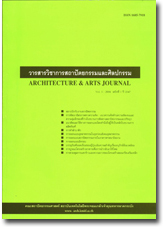An Overview of User-centered Design Approach and Usability Methods in Product Development
Main Article Content
Abstract
Product development requires a multi-disciplinary team’s knowledge to accomplish the project. Its process normally involves the development and design of a new product in coherence with the plans for its market and production. Nowadays, to cope with users’ increasing demands, the core concept of product development should not only betechnology-driven. However, it should put more emphasis on user-centered approach, which is to place the user at the center of design considerations by focusing on different types of human factors including physical, cognitive, social, and cultural human factors. Collecting and analyzing information from the product’s intended users is undeniably necessary for this approach in order to identify user requirements, needs, and expectations. Therefore, the article presented discusses the overview of user-centered approach, which is to place the user at the center of design considerations by focusing on different types of human factors including physical, cognitive, social, and cultural human factors. Collecting and analyzing information from the product’s intended users is undeniably necessary for this approach in order to identify user requirements, needs, and expectations. Therefore, the article presented discusses the overview of user-centered approach including its philosophy and practice, as well as the aspect of usability which is currently the most recognized view of user-centered design approach.
Keywords : User-centered design, Product development, Usability methods
Article Details
This work is licensed under a Creative Commons Attribution-NonCommercial-ShareAlike 4.0 International License.
Copyright Transfer Statement
The copyright of this article is transferred to Journal of The Faculty of Architecture King Mongkut's Institute of Technology Ladkrabang with effect if and when the article is accepted for publication. The copyright transfer covers the exclusive right to reproduce and distribute the article, including reprints, translations, photographic reproductions, electronic form (offline, online) or any other reproductions of similar nature.
The author warrants that this contribution is original and that he/she has full power to make this grant. The author signs for and accepts responsibility for releasing this material on behalf of any and all co-authors.

